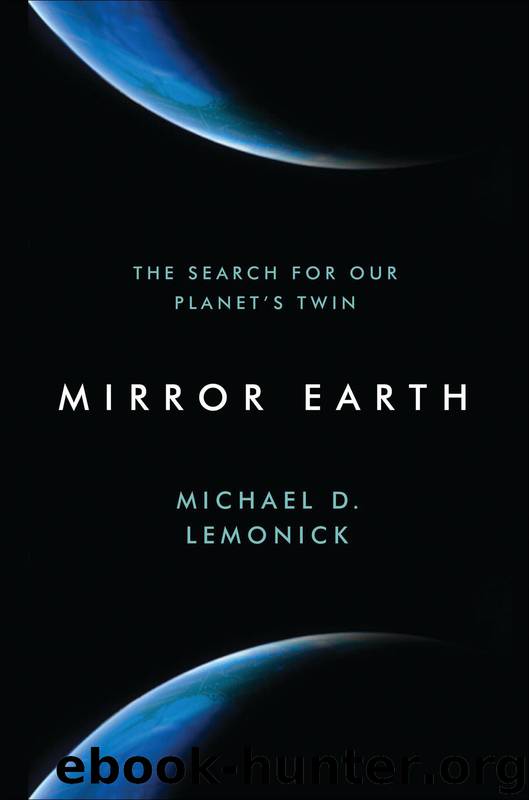Mirror Earth by Lemonick Michael D

Author:Lemonick, Michael D. [Lemonick, Michael D.]
Language: eng
Format: mobi
Publisher: Bloomsbury Publishing Plc
Published: 2012-10-06T04:00:00+00:00
Chapter 9
WAITING FOR LAUNCH
Kepler was approved in 2000, but it wouldn’t launch until 2009. It was clear to everyone in the exo-planet business that the satellite would revolutionize the science of planet-hunting—eventually. It would if Kepler was actually completed, that is, and launched without blowing up, and reached its intended orbit, and worked properly when it got there. None of those things is ever guaranteed with space probes. Even if they were, it would have been preposterous for hundreds of scientists to sit idly by waiting for Kepler for the better part of a decade when there was so much they could do in the meantime to chip away at the question of how many stars have planets, and what sort of planets they are.
So while Bill Borucki, Natalie Batalha, and the rest of the Kepler team began the long, careful process of putting together a space mission, Geoff Marcy, Paul Butler, Steve Vogt, Debra Fischer, and their collaborators and postdocs and graduate students kept measuring radial velocities. Paul Butler took the job he’d been offered at the Anglo-Australian Observatory, and then moved on to the Carnegie Institution of Washington, but he’d remained part of the team. (Like all the astronomers at the Carnegie, Butler joined the Department of Terrestrial Magnetism, whose delightfully archaic name became obsolete in 1929, when the department completed its charter task of mapping the Earth’s magnetic field.)
Michel Mayor and his group in Geneva kept at it as well, taking radial-velocity measurements, trying to squeeze down their uncertainties to find smaller and smaller planets. Sara Seager kept theorizing about planetary atmospheres and about what you’d be able to tell about an exoplanet—not just the atmosphere, but also the surface, and even the vegetation—if you could ever take a direct image if it, with something like the Terrestrial Planet Finder. For a few years, she did it at the Carnegie; then she moved on to take a faculty job at MIT. Around the world, astronomers worked harder than ever to add new worlds to the exoplanetary tote board. They wanted to be able to say something meaningful about what was out there, and they had no intention of waiting for Kepler if they didn’t have to.
And there were a lot more exoplaneteers now than there had been just a few years earlier. (They weren’t calling themselves that yet, although the term would eventually become almost universal. Dave Charbonneau is pretty sure he was the first to use it, sometime in the late 2000s.) When Marcy and Mayor announced their first exoplanets, they were operating way outside the mainstream of astronomical research. But by the time Debra Fischer got into the planet business in the late 1990s, she told me, “it felt like there was a tidal wave coming.” The approval of Kepler might have been the crest of the wave, but the swells that came before it were considerable. It wasn’t just a bigger effort from existing groups; funding requests for new searches were also starting to appear in grant-makers’ in-boxes.
Download
This site does not store any files on its server. We only index and link to content provided by other sites. Please contact the content providers to delete copyright contents if any and email us, we'll remove relevant links or contents immediately.
Tools of Titans by Timothy Ferriss(7813)
Turbulence by E. J. Noyes(7700)
Astrophysics for People in a Hurry by Neil DeGrasse Tyson(5000)
Secrets of Antigravity Propulsion: Tesla, UFOs, and Classified Aerospace Technology by Ph.D. Paul A. Laviolette(4992)
Design of Trajectory Optimization Approach for Space Maneuver Vehicle Skip Entry Problems by Runqi Chai & Al Savvaris & Antonios Tsourdos & Senchun Chai(4840)
Room 212 by Kate Stewart(4736)
Pale Blue Dot by Carl Sagan(4613)
The David Icke Guide to the Global Conspiracy (and how to end it) by David Icke(4380)
A Journey Through Divination and Astronomy by Publishing Pottermore(4249)
Apollo 8 by Jeffrey Kluger(3512)
Goodbye Paradise(3446)
Losing the Nobel Prize by Brian Keating(3425)
COSMOS by Carl Sagan(3347)
The Five People You Meet in Heaven by Mitch Albom(3334)
How to Read Water: Clues and Patterns from Puddles to the Sea (Natural Navigation) by Tristan Gooley(3240)
Brief Answers to the Big Questions by Stephen Hawking(3239)
How to Read Nature by Tristan Gooley(3078)
The Order of Time by Carlo Rovelli(3073)
A Brief History of Time by Stephen Hawking(2819)
